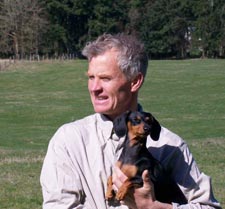By Jackie McFarland
 During the first week of the Blenheim Spring Series, which was host to final World Cup Qualifier, we took the opportunity to speak with Canadian course designer Peter Holmes.
During the first week of the Blenheim Spring Series, which was host to final World Cup Qualifier, we took the opportunity to speak with Canadian course designer Peter Holmes.
How did you become a course designer? What is your horse history?
PH: I was raised with horses in Victoria, British Columbia. My mother was a horsewoman in England, and I grew up doing a bit of everything: western, arabs, eventing and then I got into hunter-jumpers. In the late ‘70’s and early ‘80’s I started designing courses at the family farm and for the local shows. As I got into jumping we had more jumping shows. Back then, no one else would do it – designing courses was a fair bit of work. ‘Design’ usually meant not only designing the course but bringing the jumps to the show, unloading the trailer, setting the course with whomever was around plus competing on the course you designed!
After graduating college and managing a stable for ten years I started designing further afield and did my first Grand Prix for Diane and George Tidball at Thunderbird in the mid ‘80’s. My interest in course designing grew and I took it up full time in the late ‘90s. Throughout I gained valuable experience working at Spruce Meadows
Your course design mentors?
PH: Pamela Carruthers and Leopoldo Palacios.
You design courses for Children’s jumpers through World Cup Qualifiers. What factors go into the engineering of the different courses for the variety of levels?
PH: For a while I did get course designers disease – doing things that are clever, but not so good for the horses; it wasn’t good course designing. I remember one day Albert Kley (Spruce Meadows Riding Master) said to me ‘Peter, what are you doing?’ It was the trainers who talked me into coming back down to earth. Your perspective changes a lot with experience – you see things from a different viewpoint. With good course design, you want horses to go well. In the end, your goal is for the riders to have success on course and the horses to enjoy it. I truly love watching horses jump. My favorite moment is when a rider pulls up after completing a course and pats their horse.
How do you determine difficulty for the field?
PH: Coming in from Canada I may know many of these riders, but I don’t always know all the horses they are riding now. I usually do numerous things to get to know the group – first I set a more generous course early on in the week and then watch and see what’s happening. I do a lot of listening and hear tidbits from the riders. Plus I inquire with show management to see what their goals may be for the show or for a particular class.
Like a course for tonight – the final World Cup Qualifier…
PH: So I asked Robert Ridland and the technical delegate Bernie Traurig – to get their sense on how the course should ride. They know how the horses are going better than I do. They’ve seen them all season. We are all part of a team – all trying to achieve the same goal – a good experience for horse and rider. We decided not to go overly scopey – the horses jumped well on Thursday and you want the horses jumping well this close to the World Cup. We don’t want to get them backed off right before the Finals. Apparently the group has done some hard trials – so they just need a good refresher.
So would you say it’s a ‘soft course’?
PH: (as his eyes light up) Oh no, it’s definitely not soft. Anyone who thinks so should get on and give it a go!
So how many do you think will be clean?
PH: I would like to have the ones that are jumping well to be rewarded with a clean ride. Maybe five will jump clean. But in some ways you never know.
Tell us how a course like the one tonight evolves for you…
PH: You start with a piece of the course that you’re thinking about – then you work from it. Tonight – the opening line is a possible type of line you’ll see in a World Cup class. You actually have a little more room in this ring – so the four/five to a four (long to short) like I built could potentially be a three to a three in the World Cup.
Horses are fascinating – what is hard for one is not for another. Or sometimes where you think there is a test on your course, the test ends up being elsewhere. There are so many variables in the sport, it’s what keeps designing interesting.
What are your immediate and long- term goals?
PH: Well my life has changed a bit – I just got married and I am really enjoying my life at home. So now I’m adjusting my schedule, I’m not on the road for months in a row. Danielle has her own career and we both like it at home. This means designing at a few less shows and taking a few more breaks in-between shows.
A great plan – we all wish we could take more breaks! Thank you, Peter, for your time and expertise.